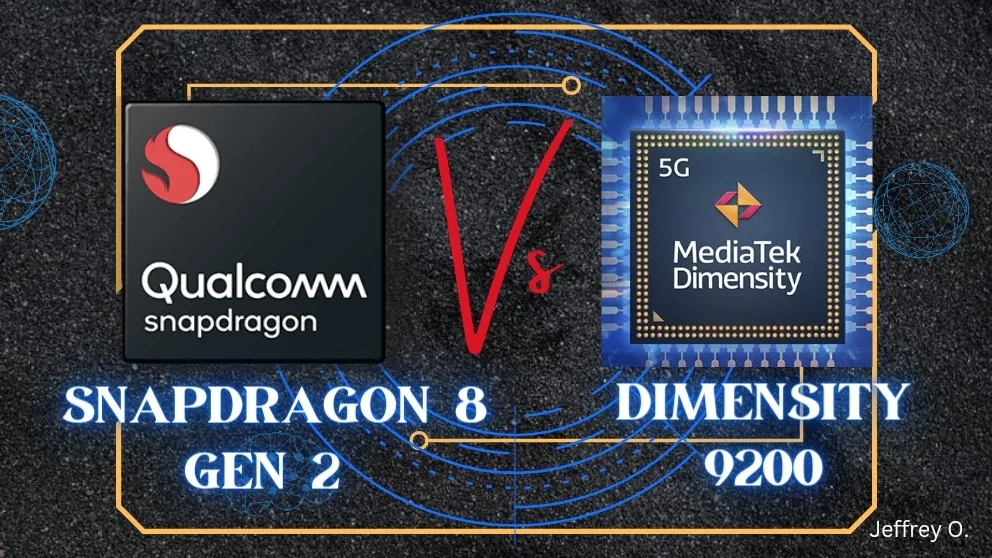Snapdragon 8 Gen 2 vs. Dimensity 9200: A true heavyweight duel
MediaTek are ready to challenge Qualcomm at the flagship level and the Dimensity 9200 is proof of that intent. However does the Dimensity 9200 stand up to the Snapdragon 8 Gen 2?
The flagship smartphone market serves as the battleground for the Android ecosystem's finest offerings. Here, we witness fierce competition between two prominent contenders: the Snapdragon 8 Gen 2 and the Dimensity 9200.
The Snapdragon 8 Gen 2, a flagship-grade SoC developed by Qualcomm, made its debut in November 2022. It is designed as a true flagship powerhouse and it lives up to the expectation.
Following the Snapdragon tradition, numerous manufacturers have eagerly embraced this SoC. Consequently, it has gained immense popularity and can be found in flagship devices such as the Xiaomi 13, 13 Pro, and 13 Ultra; Samsung Galaxy S23, S23+, and S23 Ultra; OnePlus 11, Nubia Red Magic 8s Pro, Oppo Find X6 Pro, Motorola Edge+ (2023), Honor Magic 5 Pro, and many others.
In the other corner stands the Dimensity 9200, also unveiled in November 2022. It poses as the primary rival to the Snapdragon 8 Gen 2. It's undoubtedly a capable flagship SoC, yet its adoption by smartphone manufacturers remains relatively low.
The hesitance among manufacturers can be attributed to MediaTek's relatively recent entry into the flagship segment, leading to cautious adoption of the Dimensity 9200. Nevertheless, this SoC can be found in flagship devices like the Vivo X90 and X90 Pro, Oppo Find X6, and Find N3 Flip.
Now, let's do a deep dive into the showdown between these heavyweight contenders and determine who emerges victorious.
(Snapdragon 8 Gen 2 vs. Dimensity 9200 - Full Specs Comparison Table)
Performance of Snapdragon 8 Gen 2 vs. Dimensity 9200
The competition in terms of performance is incredibly close, given that both SoCs feature nearly identical CPU cores. However, Qualcomm has introduced a surprising twist by opting for a 1+4+3 configuration, deviating from the conventional 1+3+4 arrangement employed by MediaTek. Both SoCs include a Cortex X3 prime core, Cortex A715 and A710 big cores, and Cortex A510 small cores.
That being said, these two SoCs are closely matched, but the Snapdragon 8 Gen 2 boasts a slightly faster 3.2GHz clock speed, granting it a slight edge. This distinction becomes apparent when examining benchmark test results. Nevertheless, for the average user in everyday usage, the difference may not be noticeable.
Performance: Tie
Gaming on Snapdragon 8 Gen 2 vs. Dimensity 9200
A similar narrative unfolds in terms of gaming, with a unique twist. Both SoCs possess highly capable GPUs, and they should deliver similar gaming performance. However, Qualcomm has a tradition of collaborating with game and software developers to optimize their products specifically for Adreno GPUs. Consequently, games and other applications are likely to run noticeably better on the 8 Gen 2 than on the 9200.
Gaming: Snapdragon 8 Gen 2
Cameras and Video
On paper, the Dimensity 9200 claims support for cameras with resolutions of up to 320MP, while the Snapdragon 8 Gen 2 maxes out at 200MP. Nevertheless, the 9200's ability to support 320MP sensors is somewhat irrelevant because the most advanced camera sensors available today top out at 200MP.
Regarding video capabilities, the Snapdragon 8 Gen 2 enjoys a slight advantage, as it can record 8K video at 30fps and play it back at 60fps. It also offers the ability to record and playback 4K video at 120fps. In contrast, the Dimensity 9200 can only record and playback 8K video at 30fps and 4K video at 60fps.
Camera and Video: Snapdragon 8 Gen 2
Media
Both SoCs support LPDDR5X RAM, operating at speeds exceeding 4200MHz, and UFS 3.1 and 4.0 storage. However, it's worth noting that the Dimensity 9200 can only support QHD+ displays, whereas the Snapdragon 8 Gen 2 can handle up to four displays. Nonetheless, it's important to mention that 4K display support might be considered excessive, given the rarity of smartphones equipped with 4K displays.
Media: Tie
Connectivity
Both SoCs incorporate 5G-capable modems and provide support for 4G LTE networks.
The Snapdragon 8 Gen 2 employs a Snapdragon X70 modem, theoretically capable of downloading a 1.25GB file in one second. Additionally, it supports LTE Cat. 24.
In contrast, the Dimensity 9200 lags with its MediaTek T800 5G modem, theoretically capable of downloading a maximum of 990MB in one second.
Connectivity: Snapdragon 8 Gen 2
Battery Life
Both SoCs deliver similar battery life, as they are both built on a 4nm TSMC process.
Battery Life: Tie
Conclusion
Both SoCs are highly capable and offer world-class performance. Nevertheless, owing to the slight advantages that the 8 Gen 2 possesses over the 9200, it becomes evident why many smartphone manufacturers are favoring the 8 Gen 2 over its competitor. As a result, you probably should too.
